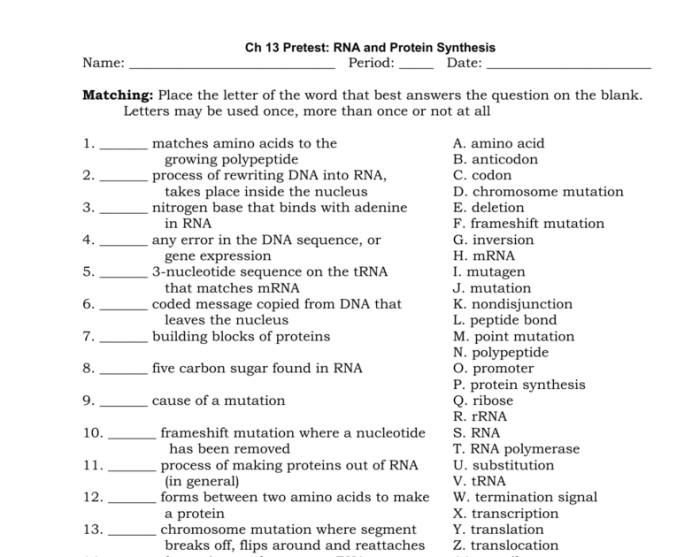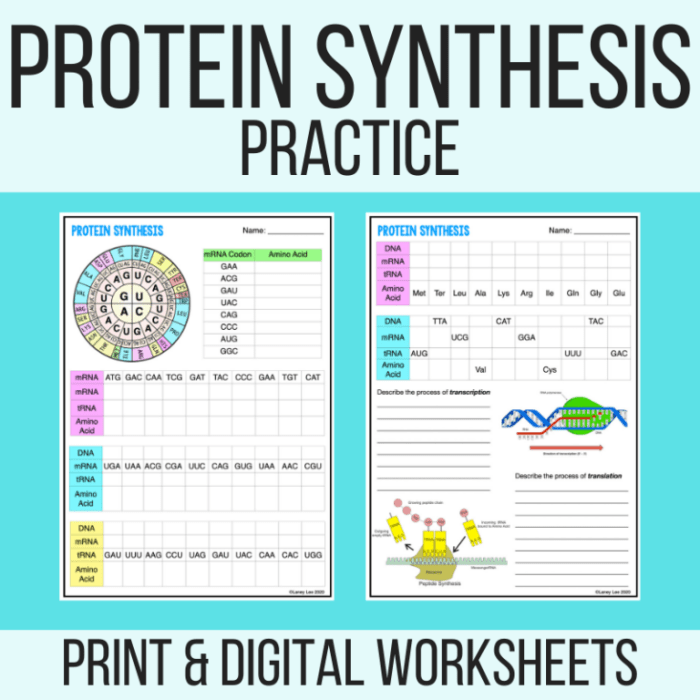Embark on a journey into the realm of protein synthesis with our meticulously crafted Protein Synthesis Webquest Answer Key PDF. This comprehensive resource unlocks the secrets of protein synthesis, providing a profound understanding of its significance in living organisms and its implications for health and biotechnology.
Delve into the intricate processes of transcription and translation, unraveling the roles of ribosomes, tRNA, and mRNA. Explore the mechanisms that regulate protein synthesis, ensuring the precise production of proteins essential for cellular function.
Introduction to Protein Synthesis
Protein synthesis is the process by which cells create proteins, which are essential for life. Proteins perform a wide range of functions in the body, including structural support, cell signaling, and metabolism.
The process of protein synthesis involves two main stages: transcription and translation. During transcription, DNA is used as a template to create a messenger RNA (mRNA) molecule. The mRNA molecule then carries the genetic information to the ribosomes, where translation occurs.
During translation, the mRNA molecule is read by transfer RNA (tRNA) molecules, which bring amino acids to the ribosomes. The amino acids are then linked together to form a protein.
Stages of Protein Synthesis

Transcription
Transcription is the process of copying the genetic information from DNA into mRNA. The process is carried out by an enzyme called RNA polymerase. RNA polymerase binds to the DNA molecule and separates the two strands of the DNA. The RNA polymerase then uses one of the DNA strands as a template to create an mRNA molecule.
Translation, Protein synthesis webquest answer key pdf
Translation is the process of converting the genetic information in mRNA into a protein. The process is carried out by ribosomes. Ribosomes bind to the mRNA molecule and move along the molecule, reading the genetic code. The ribosomes use the genetic code to determine which amino acids to add to the growing protein chain.
Post-Translational Modifications
After a protein has been synthesized, it may undergo a number of post-translational modifications. These modifications can change the structure or function of the protein. Some common post-translational modifications include glycosylation, phosphorylation, and ubiquitination.
Regulation of Protein Synthesis: Protein Synthesis Webquest Answer Key Pdf

Protein synthesis is a highly regulated process. The regulation of protein synthesis occurs at both the transcriptional and translational levels.
Transcriptional Control
Transcriptional control is the regulation of the transcription of DNA into mRNA. Transcriptional control can be mediated by a variety of factors, including transcription factors, hormones, and environmental cues.
Translational Control
Translational control is the regulation of the translation of mRNA into protein. Translational control can be mediated by a variety of factors, including microRNAs, proteins, and environmental cues.
Protein Synthesis and Disease
Protein synthesis is essential for life, but it can also be a source of disease. Mutations in genes that encode proteins can lead to a variety of diseases, including cancer and genetic disorders.
Cancer
Cancer is a disease that is characterized by the uncontrolled growth of cells. Cancer cells often have mutations in genes that encode proteins that are involved in cell growth and division.
Genetic Disorders
Genetic disorders are diseases that are caused by mutations in genes. Genetic disorders can affect any part of the body and can range in severity from mild to life-threatening.
Protein Synthesis and Biotechnology
Protein synthesis is a powerful tool that can be used to create new proteins for a variety of purposes. Recombinant DNA technology is a technique that can be used to create proteins that do not exist in nature.
Recombinant DNA Technology
Recombinant DNA technology is a technique that can be used to create proteins that do not exist in nature. The technique involves combining DNA from two different organisms to create a new DNA molecule. The new DNA molecule can then be inserted into a cell, where it will be expressed to create a new protein.
Protein Engineering
Protein engineering is a technique that can be used to modify the structure or function of proteins. Protein engineering can be used to create proteins that are more stable, more active, or more specific for a particular purpose.
Question & Answer Hub
What is the significance of protein synthesis in living organisms?
Protein synthesis is crucial for the growth, maintenance, and repair of cells and tissues. It enables the production of enzymes, hormones, antibodies, and other proteins essential for life.
How do ribosomes contribute to protein synthesis?
Ribosomes are the cellular machinery responsible for assembling amino acids into polypeptide chains, which ultimately form proteins.
What is the role of feedback mechanisms in regulating protein synthesis?
Feedback mechanisms monitor the levels of proteins in the cell and adjust the rate of protein synthesis accordingly, ensuring that protein production matches cellular needs.